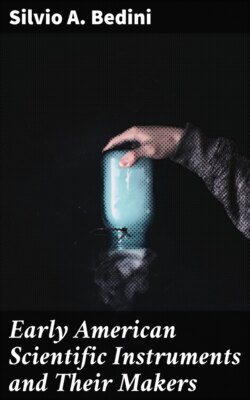Читать книгу Early American Scientific Instruments and Their Makers - Silvio A. Bedini - Страница 11
На сайте Литреса книга снята с продажи.
The Rittenhouse Brothers
ОглавлениеTable of Contents
Notable among the American practitioners was David Rittenhouse (1732–1796) of Norristown and Philadelphia, Pennsylvania, who was established as a clockmaker and surveyor in Philadelphia by 1749. He surveyed the boundary between Pennsylvania and Delaware in 1763 with instruments of his own design and construction. Six years later, in 1769, he successfully calculated the transit of Venus and later observed that planet with astronomical instruments he had constructed himself. In the following year, 1770, he built the first American astronomical observatory, in Philadelphia. Two orreries that he designed and built—at the University of Pennsylvania and at Princeton University—survive as outstanding examples of American craftsmanship.[8] Several of his surveying and astronomical instruments are exhibited in the collections of the U.S. National Museum. David Rittenhouse is credited with being the originator of a declination arc on the surveying compass, a feature to be copied by a number of later instrument makers.
David's brother, Benjamin Rittenhouse (1740-c.1820), served in the Revolution and was wounded at Brandywine. He superintended the Government's gunlock factory at Philadelphia in 1778 and achieved recognition as a maker of clocks and surveying instruments (see fig. 8).[9] During one period of his career he worked in partnership with his brother David. An interesting advertisement appeared in the May 14, 1785, issue of The Pennsylvania Packet:
WANTED, An ingenious Lad not exceeding 14 years of age, of a reputable family, as an Apprentice to learn the Art and Mistery of making Clocks and Surveying Instruments. Any lad inclining to go an apprentice to the above Trade, the terms on which he will be taken may [be] known by enquiring of Mr. David Rittenhouse, in Philadelphia, or at the subscriber's house in Worcester township, Montgomery county. Benjamin Rittenhouse.
